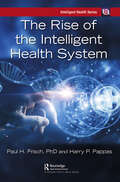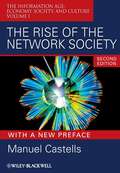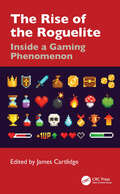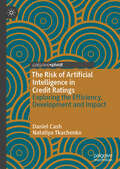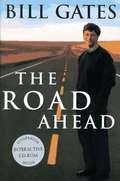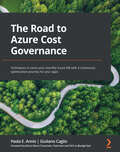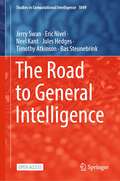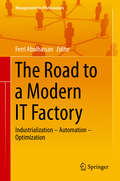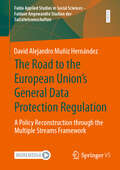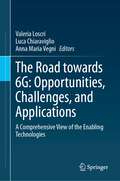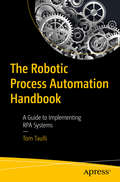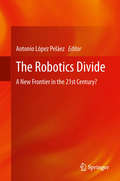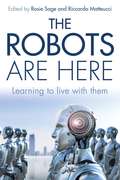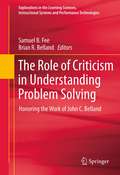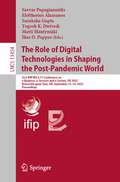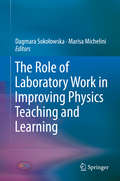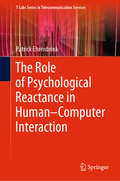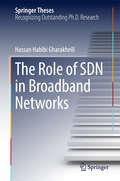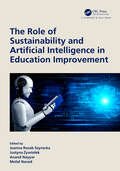- Table View
- List View
The Rise of the Intelligent Health System (Intelligent Health Series)
by Harry P. Pappas Paul H. Frisch"I recommend that all members of the health community read this book to obtain a real snapshot of how the Intelligent Health System is being transformed via new technologies." Chris Landon MD FAAP, FCCP, FRSM Clinical Associate Professor USC Keck School of Medicine Technology Development Center Laboratory and Studio The "Intelligent Health Pavilion" as demonstrated at the annual HIMSS Conference by the Intelligent Health Association is the impetus for this book. This book documents the remarkable journey of "Intelligent Health System" and the adoption of Innovative technologies. Many showcased in real time on the trade show floor and now in this book: "The Rise of the Intelligent Health System". In each chapter of this book, authors are expressing the immense potential of merging cutting-edge technology with the complex realm of patient care and safety. The informative chapters in this book delve deep into the unfolding story of how hospitals have evolved into interactive, intelligent environments, driven by real-time data and powered by artificial intelligence. In what seems like the blink of an eye, technology has completely transformed the way we live, work, and interact with the world around us. From smartphones to self-driving cars, ChatGPT, wireless technologies, wearables, and many other innovations are reshaping our society, pushing the boundaries of what was once considered impossible. However, nowhere is the impact of technology more profound than in the field of healthcare.
The Rise of the Network Society: Economy, Society, and Culture (2nd edition)
by Manuel CastellsThis first book in Castells' groundbreaking trilogy, with a substantial new preface, highlights the economic and social dynamics of the information age and shows how the network society has now fully risen on a global scale. Groundbreaking volume on the impact of the age of information on all aspects of society Includes coverage of the influence of the internet and the net-economy Describes the accelerating pace of innovation and social transformation Based on research in the USA, Asia, Latin America, and Europe
The Rise of the Roguelite: Inside a Gaming Phenomenon
by James CartlidgeThis book analyses the wave of roguelite games that has appeared over the past decade, putting them in historical context and informing readers about their development out of and relation to the roguelike genre that inspired them. The book includes discussions of the historical development and significance of roguelites, critical perspectives on topics such as gender, politics, philosophy, analyses of the influence of roguelikes on roguelites, and discussions of design and mechanics. This book will appeal to those wishing to study and learn more about the roguelites, games studies students and researchers, and game designers interested in this genre.
The Risk of Artificial Intelligence in Credit Ratings: Exploring the Efficiency, Development and Impact
by Daniel Cash Nataliya TkachenkoAs the leading credit rating agencies begin to heavily invest in the adoption of artificial intelligence, historic systemic failures serve as a reminder of the effect of mis-regulation and misdiagnosis in the credit rating world. As the industry turns towards technologies that can massively enhance the speed, efficiency, but also the temptation to transgress within the credit rating world, there are critical questions that need to be asked to shape the response that will be needed. For regulators and policymakers, the multivariant threat that the adoption of artificial intelligence within the credit rating world poses will require an extensive but nuanced response to counter it. This book presents these issues, reveals intricate implications, and provides for a considered response that regulators and policymakers should consider.
The Road Ahead
by Bill Gates Nathan Myhrvold Peter RinearsonIn this book the software pioneer describes how emerging technologies will transform human existence in unprecedented ways.
The Road to Azure Cost Governance: Techniques to tame your monthly Azure bill with a continuous optimization journey for your apps
by Paola E. Annis Giuliano Caglio Marco Barra CaraccioloGet to grips with Microsoft Azure cost management and gain complete, reliable, and sustainable control of your cloud spendKey FeaturesExplore resource rightsizing and cleanup methods and their implementationLearn key resource usage optimization conceptsUnderstand app optimization and plan for optimized and sustainable cloud native applicationsBook DescriptionCloud teams and ICT cost controllers working with Azure will be able to put their knowledge to work with this practical guide, introducing a process model for structured cost governance. The Road to Azure Cost Governance is a must-read if you find yourself facing the harsh reality of monthly cloud costs gradually getting out of control. Starting with how resources are created and managed, everything you need to know in order to track, display, optimize, rightsize, and clean up cloud resources will be tackled with a workflow approach that will leave the choice of operation to you (be it the Azure CLI, automation, logic apps, or even custom code). Using real-world datasets, you'll learn everything from basic cost management to modeling your cloud spend across your technical resources in a sustainable way. The book will also show you how to create a recursive optimization process that will give you full control of spending and savings, while helping you reserve budget for future cloud projects and innovation. By the end of this Azure book, you'll have a clear understanding and control of your cloud spend along with knowledge of a number of cost-saving techniques used by companies around the world, application optimization patterns, and the carbon impact of your cloud infrastructure.What you will learnUse Azure reporting, monitoring, and configurations to model your cloud resources and make costs clearerDiscover resource-saving techniques and put them into practiceEstablish a continuous clean-up and rightsizing processExplore and implement automation to drive recurrent savingsFind out how to use Azure Reservations in the best possible wayGet started with building cloud native, cost-optimized applicationsGet to grips with implementing cost- and carbon-aware applications on AzureWho this book is forIf you're someone who deals with Azure cloud costs and has a technical background, this book will help you understand and control your cloud spending. This book is for decision-makers, cloud managers, cloud architects, cost controllers, and software solution professionals working with Microsoft cloud services in Azure and looking to build optimized solutions for their enterprise operations.
The Road to General Intelligence (Studies in Computational Intelligence #1049)
by Bas Steunebrink Jerry Swan Eric Nivel Neel Kant Jules Hedges Timothy AtkinsonHumans have always dreamed of automating laborious physical and intellectual tasks, but the latter has proved more elusive than naively suspected. Seven decades of systematic study of Artificial Intelligence have witnessed cycles of hubris and despair. The successful realization of General Intelligence (evidenced by the kind of cross-domain flexibility enjoyed by humans) will spawn an industry worth billions and transform the range of viable automation tasks.The recent notable successes of Machine Learning has lead to conjecture that it might be the appropriate technology for delivering General Intelligence. In this book, we argue that the framework of machine learning is fundamentally at odds with any reasonable notion of intelligence and that essential insights from previous decades of AI research are being forgotten. We claim that a fundamental change in perspective is required, mirroring that which took place in the philosophy of science in the mid 20th century. We propose a framework for General Intelligence, together with a reference architecture that emphasizes the need for anytime bounded rationality and a situated denotational semantics. We given necessary emphasis to compositional reasoning, with the required compositionality being provided via principled symbolic-numeric inference mechanisms based on universal constructions from category theory.• Details the pragmatic requirements for real-world General Intelligence.• Describes how machine learning fails to meet these requirements.• Provides a philosophical basis for the proposed approach.• Provides mathematical detail for a reference architecture.• Describes a research program intended to address issues of concern in contemporary AI.The book includes an extensive bibliography, with ~400 entries covering the history of AI and many related areas of computer science and mathematics.The target audience is the entire gamut of Artificial Intelligence/Machine Learning researchers and industrial practitioners. There are a mixture of descriptive and rigorous sections, according to the nature of the topic. Undergraduate mathematics is in general sufficient. Familiarity with category theory is advantageous for a complete understanding of the more advanced sections, but these may be skipped by the reader who desires an overall picture of the essential conceptsThis is an open access book.
The Road to Outsourcing 4.0: Next-Generation Supply Chain
by Mohammadreza AkbariThis book provides valuable insights and guidance for firms looking to improve their operations in the face of disruption and uncertainty. It contributes to the body of knowledge in logistics and supply chain disciplines which will be useful to both industry practitioners and academics. With this, the book first emphasizes the road to outsourcing 4.0 by providing updated information and perspectives on these trends, given that outsourcing has evolved significantly over the years and new technologies, such as artificial intelligence (AI), cloud computing, Internet of Things (IoT), and machine learning are changing the way outsourcing is done. In addition, the book also explores new models such as third-party logistics (3PL) providers and crowdsourcing which have changed the landscape of outsourcing. Lastly, the book includes updated best practices for outsourcing, including how to choose outsourcing partners, manage outsourcing relationships, and minimize risks in the post-COVID-19 recovery period. Each chapter in the book goes through concepts, development histories, benefits, risks and challenges, and includes recent case studies
The Road to a Modern IT Factory
by Ferri AbolhassanIT is currently going through one of its most critical phases of transformation. IT vendors and IT service organizations are revolutionizing their production and service processes, adopting industrial practices. It is only through the consistent transformation into factory-like structures that quality, effectiveness and efficiency can be increased. By integrating professional concepts and methods taken from the context of industrial production, it is possible to meet functional and qualitative requirements from the departments and therefore from the end user. On top of that this new paradigm enables the implementation of optimal processes in the organization. An interdisciplinary team of authors addresses the current challenges for global IT services organizations and describes the process of IT industrialization. The transformation of the IT industry towards the model of an IT factory is the core theme of this book, which takes the latest findings from applied research, consulting and IT business practices and combines them into a consistent and innovative approach to IT services.
The Road to the European Union's General Data Protection Regulation: A Policy Reconstruction through the Multiple Streams Framework (Fulda Applied Studies in Social Sciences – Fuldaer Angewandte Studien der Sozialwissenschaften #2)
by David Alejandro Muñiz HernándezThis book offers a policy analysis of the emergence of the General Data Protection Regulation (GDPR) through the lens of John Kingdon&’s Multiple Streams Framework. Drawing on 32 expert interviews with key stakeholders—including EU institution representatives (such as trilogue negotiators), member states, industry leaders, NGOs, and journalists—the author provides a deep dive into the decision-making process behind the regulation. Additionally, the study examines 462 position papers from the EU Commission&’s consultation phases (2009–2011) to uncover the factors that shaped the adoption of the GDPR. At its core, this work explores the &‘window of opportunity&’ that enabled the regulation's adoption.
The Road towards 6G: A Comprehensive View of the Enabling Technologies
by Valeria Loscri Anna Maria Vegni Luca ChiaraviglioThe proposed book will provide a comprehensive picture of the journey from 5G networks towards 6G. Different aspects, ranging from theoretical foundations to existing platforms and technologies will be presented and analysed, by critically highlighting the real opportunities and the challenges. The first chapters are to describe the general “transitioning” aspects from 5G to 6G. After that, an overview on the different technologies is provided, to present at the end the security aspects, the new applications and an analysis of the electromagnetic exposure, above all in terms of comparative in respect of 5G. Security and Application will be straightforward better explained after the big picture on the different technologies is detailed in the previous chapters. 6G is an emerging complex paradigm, with some important new concepts, that would enable an extremely high reliability and low latency. The main purpose is to provide the reader a thorough vision of the enabling technologies, their potential and what is still needed to fill the gap in terms of sustainability and coexistence of the different technologies. Since different emerging technologies will be considered and detailed in the book, it will be interesting for the reader to infer the major opportunities of each and the main limitations. This kind of information will mainly boost the potential interactions of different technologies to provide a more reliable system.
The Robot and Us: An 'Antidisciplinary' Perspective on the Scientific and Social Impacts of Robotics (Biosystems & Biorobotics #20)
by Maria Chiara CarrozzaThis book offers a clear, yet comprehensive overview of the role of robots in our society. It especially focuses on the interaction between humans and robots, and on the social and political aspects of the integration of robots with humans, in their everyday life, both in the private and working sphere alike. Based on the lessons held by the author at “Scuola di Politiche” (transl. School of Political Sciences), this self-contained book mainly addresses an educated, though not-specialist, audience.
The Robotic Process Automation Handbook: A Guide to Implementing RPA Systems
by Tom TaulliWhile Robotic Process Automation (RPA) has been around for about 20 years, it has hit an inflection point because of the convergence of cloud computing, big data and AI. This book shows you how to leverage RPA effectively in your company to automate repetitive and rules-based processes, such as scheduling, inputting/transferring data, cut and paste, filling out forms, and search. Using practical aspects of implementing the technology (based on case studies and industry best practices), you’ll see how companies have been able to realize substantial ROI (Return On Investment) with their implementations, such as by lessening the need for hiring or outsourcing. By understanding the core concepts of RPA, you’ll also see that the technology significantly increases compliance – leading to fewer issues with regulations – and minimizes costly errors. RPA software revenues have recently soared by over 60 percent, which is the fastest ramp in the tech industry, and they are expected to exceed $1 billion by the end of 2019. It is generally seamless with legacy IT environments, making it easier for companies to pursue a strategy of digital transformation and can even be a gateway to AI. The Robotic Process Automation Handbook puts everything you need to know into one place to be a part of this wave. What You'll LearnDevelop the right strategy and planDeal with resistance and fears from employeesTake an in-depth look at the leading RPA systems, including where they are most effective, the risks and the costsEvaluate an RPA systemWho This Book Is For IT specialists and managers at mid-to-large companies
The Robotics Divide: A New Frontier in the 21st Century?
by Antonio López PeláezSocieties survive in their environment and compete with each other depending on the technology they develop. Economic, military and political power are directly related to the available technology, while access to technology is key to the well-being of our societies at the individual, community and national level. The Robotics Divide analyzes how robotics will shape our societies in the twenty-first century; a time when industrial and service robotics, particularly for military and aerospace purposes, will become an essential technology. The book, written by experts in the field, focuses on the main technological trends in the field of robotics, and the impact that robotics will have on different facets of social life. By doing so, the authors aim to open the "black box" of a technology which, like any other, is designed, implemented and evaluated according to the economic and cultural patterns of a cosmopolitan society, as well as its relations of power. The Robotics Divide explores future developments in robotics technology and discusses the model of technological development and the implementation of robotics in this competitive market economy. Then the authors examine to what extent it is possible to determine the characteristic features of the robotic divide, namely in what ways the robotic divide differs from the digital divide, and how a model to integrate this technology can be developed without reproducing patterns of inequality and power that have characterized the advent of previous technologies. These issues - inequality, robotics and power - are of concern to robotics and advanced automation engineers, social scientists, economists and science policy experts alike.
The Robots are Here
by Rosemary Sage Riccarda MatteucciTechnology is redefining what it means to live in society and be human.This book assembles research and practice on educational robotics (intelligent machines) with a particular focus on the practices in Britain and Italy, the latter of which is a leading nation in preparing students for the New Industrial Age.Now that intelligent machines are capable of undertaking all routing tasks, robotics can provide three-dimensional development - personal, practical and academic - for the improved communication and thinking that students need for higher-level work. Students no longer need drilling in facts, now accessed by the touch of a button, but require greater attention to personal and practical abilities to meet global challenges.Readers are made aware of new learning approaches to achieve the flexible, broader abilities that aid survival and well-being.
The Rockstars of JVZoo.com: How Regular People Have Made a Fortune Buying and Selling on the World's Fastest Growing Ecommerce Platform
by Joel CommWhat Does it Take to Be an Online RockstarJVZoo is an amazing resource for entrepreneurs to turn their knowledge into digital products and recruit hundreds or thousands in their field to promote those products. Whether you are a business consultant, lawyer, real estate agent, or even someone who knows how to build the perfect birdhouse, JVZoo allows you to put your knowledge into a format that can be sold and profited from. While the rest of the world looks for jobs, JVZoo’s members create their own.In the three years that JVZoo has been around, it’s members have generated over $100 million in sales revenue. Our members are mainly people who started making money online as a part-time venture.Rockstars of JVZoo is a compilation of case studies, written by people just like you, people who listened to their inner voices and created jobs for themselves. Everything you are about to read in this book has been achieved by ordinary people who did that one thing that separates entrepreneurs from the rest of society: they took action.
The Role of AI in Bio-Medical Translations’ Research for the Health Care Industry: First International Conference, AIBTR 2023, Nagpur, India, September 23, 2023, Revised Selected Papers (Communications in Computer and Information Science #1987)
by Sivaram Ponnusamy Vibha Rajesh BoraThis book constitutes the revised selected papers of the First International Conference, AIBTR 2023, held in Nagpur, India, during September 22–23, 2023.The 7 full papers included in this volume were carefully reviewed and selected from 37 submissions. The papers contained in this book discuss the application of Artificial Intelligence in Biomedical Engineering for the Health Care industry.
The Role of Clean Coal Technologies in Energy Transformation and Energy Security: Ensuring Energy Security: The Key Role of Clean Coal Technologies in the Energy Transition (SpringerBriefs in Energy)
by Aurelia Rybak Aleksandra RybakThis book presents the latest achievements in the field of clean coal technologies and shows how these innovations contribute to environmental protection and ensure stability of energy supplies. The book describes how clean coal technologies can revolutionize our energy future. From advanced mining methods to modern energy storage solutions, this book is a source of knowledge about sustainable development and technological innovation.
The Role of Criticism in Understanding Problem Solving
by Samuel Fee Brian BellandIn 1991, Denis Hlynka and John Belland released Paradigms Regained, a well received reader for graduate students in the field of educational technology. The Role of Criticism in Understanding Problem Solving updates some of those ideas initially proposed in Paradigms Regained, and extends the conversation into the contemporary discourse regarding problem based learning (PBL). Paradigms proposed the idea of criticism as a third method for the conduction of educational research, the first two being qualitative and qualitative. The concept of criticism as a tool for research is not well established in educational technology, although it is well established in other educational research traditions such as Curriculum Studies. Unfortunately, it is not always clear how criticism can be applied. This book views criticism as a way to step back and look at an educational intervention within educational technology through a particular critical lens. Criticism is viewed as a valuable approach to guiding meta analyses and theoretical studies, serving to prevent the proverbial "spinning of the wheels" that often happens in educational research. By indicating new potential research questions and directions, criticism approaches can invigorate educational research. This book revisits the ideals of criticism in order to establish their usefulness for studying educational technology interventions to support problem based learning. First, a few foundational chapters set the stage for the conversations on criticism. Then, the role criticism can play in enhancing analysis and interpretation of the PBL literature is explored. Finally, case studies addressing the central concepts of the text are presented and dissected. This book represents a complete overhaul and rethinking of the use of criticism as a method for understanding and furthering the research area of PBL within the field of Educational technology.
The Role of Digital Technologies in Shaping the Post-Pandemic World: 21st IFIP WG 6.11 Conference on e-Business, e-Services and e-Society, I3E 2022, Newcastle upon Tyne, UK, September 13–14, 2022, Proceedings (Lecture Notes in Computer Science #13454)
by Yogesh K. Dwivedi Matti Mäntymäki Ilias O. Pappas Suraksha Gupta Savvas Papagiannidis Eleftherios AlamanosThis book constitutes the refereed proceedings of the 21st IFIP WG 6.11 Conference on e-Business, e-Services, and e-Society, I3E 2022, which took place Newcastle-upon-Tyne, UK, in September 2022. The 37 papers presented in this volume were carefully reviewed and selected from 72 submissions. They were organized in topical sections as follows: Artificial intelligence; Data and Analytics; Careers and ICT; Digital Innovation and Transformation; Electronic Services; Health and Wellbeing; Pandemic; Privacy, Trust and Security.
The Role of Laboratory Work in Improving Physics Teaching and Learning
by Marisa Michelini Dagmara SokołowskaThis book explores in detail the role of laboratory work in physics teaching and learning. Compelling recent research work is presented on the value of experimentation in the learning process, with description of important research-based proposals on how to achieve improvements in both teaching and learning. The book comprises a rigorously chosen selection of papers from a conference organized by the International Research Group on Physics Teaching (GIREP), an organization that promotes enhancement of the quality of physics teaching and learning at all educational levels and in all contexts. The topics covered are wide ranging. Examples include the roles of open inquiry experiments and advanced lab experiments, the value of computer modeling in physics teaching, the use of web-based interactive video activities and smartphones in the lab, the effectiveness of low-cost experiments, and assessment for learning through experimentation. The presented research-based proposals will be of interest to all who seek to improve physics teaching and learning.
The Role of Psychological Reactance in Human–Computer Interaction (T-Labs Series in Telecommunication Services)
by Patrick EhrenbrinkThis book provides an in-depth investigation on the psychological phenomenon "reactance“ in the context of Human-Computer Interaction (HCI). The author argues that the complexity and autonomy of modern technology can sometimes be overwhelming and can then be perceived as a threat to freedom by its users, thereby diminishing acceptance. The book investigates if and how this is the case and provides strategies to regain the lost acceptance. Topics include relevance of reactance on HCI, triggers for reactance, consequences of reactance, measurement of reactance, and countermeasures to reactance.
The Role of SDN in Broadband Networks
by Hassan Habibi GharakheiliThis thesis focuses on the design and use of software defined networking (SDN) in residential Internet service providers (ISPs), as well as innovative operational models that can be incorporated in broadband ecosystems. Though SDN addresses the challenges for bundled best-effort service provided by broadband operators for users, it does not distinguish between the different types of applications (video streaming, web-browsing, and large file transfers), nor does it cater to the varying needs of different household devices (entertainment tablets, work laptops, or connected appliances). This is a problem for end-users, who want to differentiate between applications and devices; for content providers (CPs), who want to exercise control over streams of high monetary value; and for Internet service providers (ISPs), who have to accommodate growing traffic volumes without additional revenues. This book develops a series of solution techniques that use SDN to find an optimal balance between the competing requirements of end-users, ISPs, and CPs. In addition to the design and discussions of various architectures, it provides technical details on real-world system implementations and prototypes. As such, it offers a valuable resource for researchers, network architects, network strategists, developers, and all other readers seeking to learn more about the practical value of SDN in future ISP networks.
The Role of Sustainability and Artificial Intelligence in Education Improvement
by Anand Nayyar Mohd Naved Justyna Żywiołek Joanna Rosak-SzyrockaThis book is devoted to the issues faced by universities in the field of distance learning during and after COVID, as well as in digitalization times. The book devotes a lot of space to the issues of Web 3.0 in university e-learning, Industry 4.0, artificial intelligence and digital equity. The aim and scope of this book is to draw a holistic picture of education before and after COVID, the psychological effects of COVID in education, and using modern technologies application in education, taking into consideration aspects of sustainability development, Industry 4.0 and Society 5.0. The authors also raise the issue of artificial intelligence investigation in learner-instructor interaction. Features: • To elaborate the functions of online education and numerous pedagogical strategies based on electronic learning to aid teachers and students with the tools required to succeed in the 21st century via engaging virtual experiences• To analyze tools provided by Ed-Tech firms and the effect of digital tools on maintaining the educational process in times of crisis and after pandemic• To create a roadmap for higher education institutions and provide tips regarding how to improve the effectiveness of the hybrid learning system• To understand e-learning characteristic in the era of Industry 4.0 and Society 5.0 and characteristics of the different web generations• To use AI applications to improve connections and relationships between students and teachers and in education in the future The book is both scientific and educational. It can be used at the university level and by anyone interested in the topics it covers.
The Role of Technology in Distance Education (Routledge Revivals)
by Tony BatesThis book, first published in 1984, provides a comprehensive review of the range of technology that was being used in distance education. Technological developments in word processing, video-disc and viewdata as well as computer-based learning had revolutionised the potential for distance education. These developments required the role of more ’conventional’ distance learning media, such as broadcasting, tuition and text, to be reassessed. This book, written by international experts in the field, explored the state of the art at the time, and also provided their ideas on how future developments were likely to evolve. This book is ideal for those studying education and communications.
